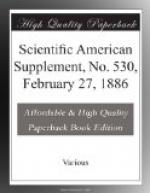In order that the effect may be good, it is necessary that the objects be not uniform. Their surface must be naturally carved and hollowed, and the projecting parts must detach themselves well from each other. The number of species now used is relatively large, but a selection from these will inevitably be made. Some patterns will be better liked than others, and ladies who are to wear these new trimmings this winter will be able to make their choice of them at the fashion stores. When such articles as these make their appearance, they often spread with surprising rapidity. It is now but a few days since the great dressmaker Worth adopted them, and the linen trade already has them in stock. We recently saw at Suzange’s some linen aprons and collars ornamented with small groups of fruits and seeds prepared by the Collin process, and which produced a most pleasing effect. The idea has even occurred to apply these trimmings to furniture and upholstery.
In the manufacture of these articles the cones of several species of Casuarina, the tags of alder, as well as the naturally carved fruits of certain Eloeocarpi of India and Australia, were first used; then came the fruits of the umbelliferous plant, Oenanthe, the spiral pods of Medicago, the fruit of the water-caltrops, Melia and Zizyphus, the cups of the acorn, the involucres of the beech, the seeds of Coix lacryma, etc.
The naturalist ought to be glad to see objects that form the base of his studies taking a direction favorable to the industry of his country.
On another hand, these products themselves cannot fail to arouse the curiosity of ladies who have the instinct of observation. And, who knows? Perhaps a frock or mantle trimmed with these vegetable ornaments may prove a more certain propaganda in favor of botany than the most classic lessons on this gentle, science!—La Nature.
* * * * *
DEW.
[Footnote: Abstract of paper read before the Royal Society of Edinburgh on Dec. 21, 1885, by Mr. Aitken, communicated by permission of the Council of the Society.—Nature.]
The first point referred to in this paper is the source of the vapor that condenses to form dew. A short historical sketch is given of the successive theories from time to time advanced on this point, showing how in early times dew was supposed to descend from the heavens, and then afterward it was suggested that it rose from the earth, while Dr. Wells, who has justly been considered the great master of this subject, thought it came neither from above nor from below, but was condensed out of the air near the surface of the earth. He combated Gersten’s idea that it rose from the earth, and showed that all the phenomena observed by Gersten and others which were advanced to support this theory could be equally well explained according to the theory that it was simply formed from the vapor present at the time in the air, and which had risen from the ground during the day, and concluded that if any did rise from the ground during night, the quantity must be small, but, with great caution, he adds that “he was not acquainted with any means of determining the proportion of this part to the whole.”




